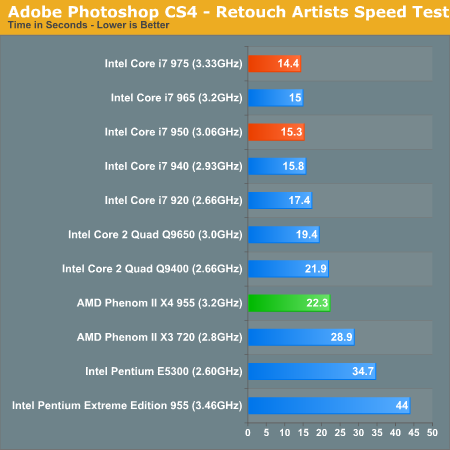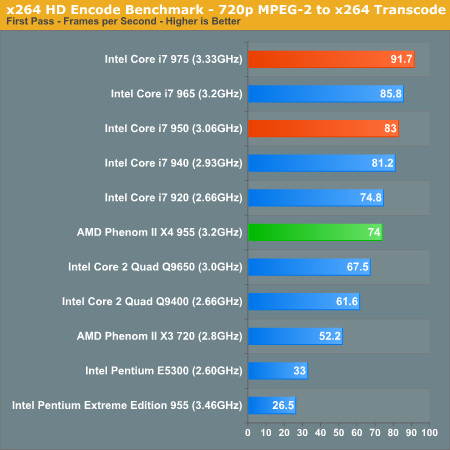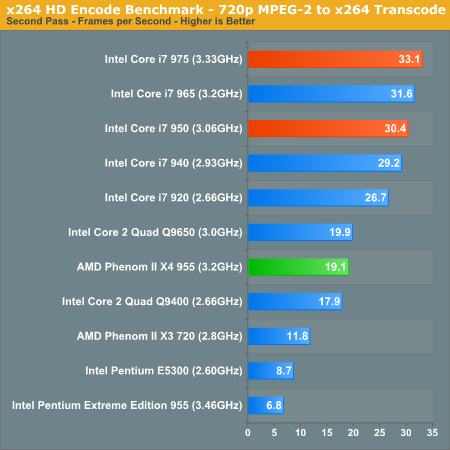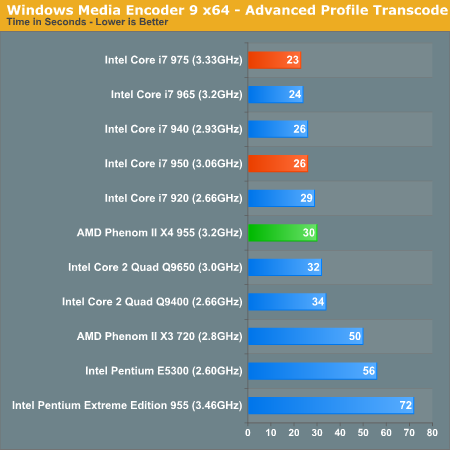Intel’s Core i7-975 & 950: Preparing for Lynnfield
by Anand Lal Shimpi on June 3, 2009 12:00 AM EST- Posted in
- CPUs
Adobe Photoshop CS4 Performance
To measure performance under Photoshop CS4 we turn to the Retouch Artists’ Speed Test. The test does basic photo editing; there are a couple of color space conversions, many layer creations, color curve adjustment, image and canvas size adjustment, unsharp mask, and finally a gaussian blur performed on the entire image.
The whole process is timed and thanks to the use of Intel's X25-M SSD as our test bed hard drive, performance is far more predictable than back when we used to test on mechanical disks.
Time is reported in seconds and the lower numbers mean better performance. The test is multithreaded and can hit all four cores in a quad-core machine.

Whoever said there's no room for CPU performance improvements anymore would be very wrong. While the Pentium E5300 is more than sufficient for most tasks, there's nearly a 60% difference between its performance and the class leading Core i7-975. Even the Phenom II X4 955 takes 55% longer to complete this test.
The performance advantage is there, but it's one that you definitely pay for. The i7-975 is around 4x the price of the Phenom II X4 955.
DivX 8.5.3 with Xmpeg 5.0.3
Our DivX test is the same DivX / XMpeg 5.03 test we've run for the past few years now, the 1080p source file is encoded using the unconstrained DivX profile, quality/performance is set balanced at 5 and enhanced multithreading is enabled:

x264 HD Video Encoding Performance
Graysky's x264 HD test uses the publicly available x264 codec (open source alternative to H.264) to encode a 4Mbps 720p MPEG-2 source. The focus here is on quality rather than speed, thus the benchmark uses a 2-pass encode and reports the average frame rate in each pass.

The i7-975 is over 70% faster than AMD's fastest in our x264 encode test, and 3.85x the speed of the old Pentium EE 955. Even compared to the Core i7-920, the 975 is ~24% faster.

Windows Media Encoder 9 x64 Advanced Profile
In order to be codec agnostic we've got a Windows Media Encoder benchmark looking at the same sort of thing we've been doing in the DivX and x264 tests, but using WME instead.











44 Comments
View All Comments
mapesdhs - Monday, May 11, 2020 - link
Hello from 2020. Oh my how the worm hath turned. :) Took a while though.strikeback03 - Wednesday, June 3, 2009 - link
How many people bought a 940 or 965 anyway? Seems the vast majority of i7 sales were the 920, and then people OCed them. Guess we have to wait and see the OC results on the retail processors, but I'm guessing a lot more people would be happy to see a speed bumped 920 than these processors.aeternitas - Sunday, June 7, 2009 - link
Take a look around at where you're, then ask yourself why you get that impression?rundll - Wednesday, June 3, 2009 - link
Just wondering what happens to the Turbo Mode when you overclock a processor? Does it stop working, does it become obsolete? Is it useful only as long as you stick to stock specs?Anyone?
Anand said something about coming tests with retail i7-975. Is it possible to include some oc:ed i7-920 benchmarking results as well? That'd be great.
Gary Key - Wednesday, June 3, 2009 - link
Turbo remains active during overclocking and depending on the BIOS, it remains active even if TDP limits are exceeded. I have the retail 975 coming and will provide overclocked numbers in a separate article centering on memory performance. Personally, buying a good 920 DO and overclocking it is your best option at this point unless you need a higher multiplier for extreme clocking, at which point the Xeon W3540 will provide you with the best bang for buck overclocks in this area. The unlocked multis on the 975 might allow a slightly better overclock or ability to clock memory, but maybe 0.02% of users will need it. I just have not found any general retail (not special binned from Intel) 975s that have out clocked the W3540s up high at this point and my retail 920 D0s just embarrass this 975 ES sample.rundll - Wednesday, June 3, 2009 - link
Tks Gary, tks hemipowered.All clear now except that I just can't quite figure it out how the Turbo can pump up the volume after I've od:ed the cpu to max. Does it push it up to max+? Am I missing something here?
If anyone sees it fit to answer, tks for that.
hemipowered - Wednesday, June 3, 2009 - link
You can overclock and keep turbo on, I dohyvonen - Wednesday, June 3, 2009 - link
I understand that gaming needs ATI/NVidia discrete cards, but just once I'd really like to see the power consumption numbers quoted without these power hogs...I'm interested in a quiet Media PC that plays BluRay/HD fine, does MP3/video encoding well, and could be used as a near-zero-load 24/7 file server (low idle power consumption). I have a PS3 for gaming; my PC would be fine with integrated graphics. But all the benchmarking setups are loaded with high-end graphics cards, massive PSUs and a ton of memory.
None of the reviews show me how much the idle power of the CPU is, or that of the chipset/motherboard. I'm sure it's hard as hell to itemize the power consumptions of the components, but that's what I'm hoping Anand's team can figure out.
I'd really like to see how AMD/ATI and Intel platforms work from performance/power point of view in low-power HTPC-like systems (with SSDs etc.). How much power does DDR2/DDR3 really consume? What about undervolting/clocking? Undervolting DDR3? Small-cache/small-size CPUs? Power/performance numbers are always for testbenches, never for CPUs themselves, and the leaky discrete graphics chips always mess up the results.
I have a feeling that the Westmere dual-core desktop/mobile CPUs are going to be perfect for this sort of a system; 100W PicoPSU, SSD, WD Green HD... I just can't find the information anywhere.
strikeback03 - Wednesday, June 3, 2009 - link
http://www.anandtech.com/casecoolingpsus/showdoc.a...">http://www.anandtech.com/casecoolingpsus/showdoc.a...too old to have i7 stuff in it, but you probably wouldn't want that in your system anyway.
For reference, my desktop here at work has a 650W Enermax Infiniti PSU, Q6600@3GHz, P35 chipset, 1HDD, 1optical drive, 3 1GB sticks of DDR2, and a passive cooled nVidia 7300GT, and idles at just over 100W at the wall.
To use a PicoPSU you probably need better info on what the components draw on each rail. When power is so limited it matters, I lost a M3-ATX due to that.
hyvonen - Wednesday, June 3, 2009 - link
Thanks for the link - that article was great! I don't know how I missed it...I really hope they'll redo that stuff later with the new CPUs (especially the Westmere ones with IGP-in-the-package) and the new chipsets (P55 etc.)
What happened with the PicoPSU/M3ATX?